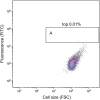Design and application of artificial rare L-lysine codons in Corynebacterium glutamicum
- PMID: 37324439
- PMCID: PMC10268032
- DOI: 10.3389/fbioe.2023.1194511
Design and application of artificial rare L-lysine codons in Corynebacterium glutamicum
Abstract
Background: L-lysine is widely used in the feed, food, and pharmaceutical industries, and screening for high L-lysine-producing strains has become a key goal for the industry. Methods: We constructed the rare L-lysine codon AAA by corresponding tRNA promoter replacement in C. glutamicum. Additionally, a screening marker related to the intracellular L-lysine content was constructed by converting all L-lysine codons of enhanced green fluorescent protein (EGFP) into the artificial rare codon AAA. The artificial EGFP was then ligated into pEC-XK99E and transformed into competent Corynebacterium glutamicum 23604 cells with the rare L-lysine codon. After atmospheric and room-temperature plasma mutation and induction culture, 55 mutants (0.01% of total cells) with stronger fluorescence were sorted using flow cytometry, and further screened by fermentation in a 96-deep-well plate and 500 mL shaker. Results: The fermentation results showed that the L-lysine production was increased by up to 9.7% in the mutant strains with higher fluorescence intensities, and that the highest screening positive rate was 69%, compared with that in the wild-type strain. Conclusion: The application of artificially constructed rare codons in this study represents an efficient, accurate, and simple method for screening other amino acid-producing microorganisms.
Keywords: Corynebacterium glutamicum; L-lysine; gene knockout; high flux; rare codon.
Copyright © 2023 Yang, Peng, Yang, Du, Guo, Sui, Wang, Li, Wang and Li.
Conflict of interest statement
Authors CG, SS, JiW, and JL were employed by the company Zhucheng Dongxiao Biotechnology Co., Ltd. The remaining authors declare that the research was conducted in the absence of any commercial or financial relationships that could be construed as a potential conflict of interest.
Figures









Similar articles
-
Metabolic engineering of Corynebacterium glutamicum for enhanced production of 5-aminovaleric acid.Microb Cell Fact. 2016 Oct 7;15(1):174. doi: 10.1186/s12934-016-0566-8. Microb Cell Fact. 2016. PMID: 27717386 Free PMC article.
-
Industrial production of L-lysine in Corynebacterium glutamicum: Progress and prospects.Microbiol Res. 2022 Sep;262:127101. doi: 10.1016/j.micres.2022.127101. Epub 2022 Jun 25. Microbiol Res. 2022. PMID: 35803058 Review.
-
Integration of ARTP mutagenesis with biosensor-mediated high-throughput screening to improve L-serine yield in Corynebacterium glutamicum.Appl Microbiol Biotechnol. 2018 Jul;102(14):5939-5951. doi: 10.1007/s00253-018-9025-2. Epub 2018 May 3. Appl Microbiol Biotechnol. 2018. PMID: 29725721
-
Rational reformation of Corynebacterium glutamicum for producing L-lysine by one-step fermentation from raw corn starch.Appl Microbiol Biotechnol. 2022 Jan;106(1):145-160. doi: 10.1007/s00253-021-11714-z. Epub 2021 Dec 6. Appl Microbiol Biotechnol. 2022. PMID: 34870736
-
Boosting Anaplerotic Reactions by Pyruvate Kinase Gene Deletion and Phosphoenolpyruvate Carboxylase Desensitization for Glutamic Acid and Lysine Production in Corynebacterium glutamicum.Adv Biochem Eng Biotechnol. 2017;159:181-198. doi: 10.1007/10_2016_31. Adv Biochem Eng Biotechnol. 2017. PMID: 27872961 Review.
Cited by
-
Construction and screening of L-valine high-yielding Escherichia coli using an artificial screening marker.Front Microbiol. 2025 Aug 7;16:1627242. doi: 10.3389/fmicb.2025.1627242. eCollection 2025. Front Microbiol. 2025. PMID: 40851858 Free PMC article.
References
LinkOut - more resources
Full Text Sources

